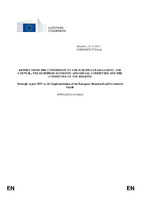| dc.description.abstract | The main purpose of the European Structural and Investment Funds1('ESI Funds') is to foster lasting socio-economic convergence, resilience and territorial cohesion. The Funds deliver a critical mass of investments in priority areas of the EU through shared management between the Commission and the Member States. By supporting job creation, growth and investment, strengthening the Single Market, the Energy Union and economic governance these investments respond to the needs of the real economy. The Funds also greatly help the EU achieve its political objectives by translating them into action on the ground.This Report2provides the first strategic overview of the implementation of the 2014-2020 ESI Funds programmes which run until the end of 2023. It summarises Member States' implementation and progress reports3,covering the years 2014 to 2016. It is therefore focused on the progress of implementation as evidenced by the data on selected projects. The accompanying Staff Working Document provides more details.The ESI Funds provide a stable, long-term investment frameworkfor Member States and their regions. With a budget of EUR 454 billion for 2014-2020, the ESI Funds are the EU's main tool for investment. National public and private co-financing is expected to reach at least EUR184billion, bringing total investment to EUR 638 billion. The ESI Funds also help Member States to improve the investment environment. This includes supporting structural reforms to mobilise private capital and introducing ex-ante conditionality. The current generation of programmeshas incorporated significant reforms and more funding than ever before is now concentrated in areas of highest EU value added, such as employment, social inclusion, skills, research and innovation, the environment or the low-carbon economy4. The Funds also help authorities and stakeholders to think EU wide or even globally when acting locally. This leads to better strategic planning and a greater capacity to deliver. Looking at the first three years of the 2014-2020 programmes, initial achievements5are appearing. Around 2 million projects have been selected all over Europe, amounting to EUR182 billion or 28.4% of the total financing available for the period. 793490 businesses are being supported and 7.8 million people have been helpedso far in their search for a job, training, or education. About 20% of the total agricultural area is covered by climate and environment related actions following investments to improve biodiversity, soil and water management.The Member States' reports highlight that the number of projects selected in2016 rose sharply, indicating that Member States are reaching full speed in turning the ESI Funds into concrete results and improving people’s lives in Europe. Investment is progressing well in many of the areas targeted as a priority forthe EU with, for instance, 31% of the total planned investment in competitiveness of Small and Medium-sized Enterprises (SMEs) allocated to projects. |

